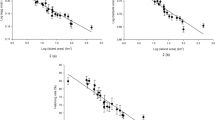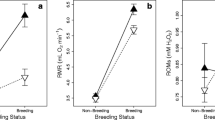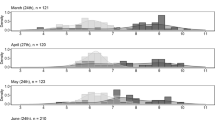Abstract
Geographic variation in maternal investment in offspring size can be adaptive if differences in investment translate into improved offspring performance in the given environments. We compared two moor frog, Rana arvalis, populations in the laboratory to test the hypothesis that investment in large eggs in populations originating from stressful (acid) environments improves offspring performance when reared in stressful (acid) conditions. We found that large initial size (hatchling mass) had moderate to strong, environment-dependent positive effects on larval and metamorphic traits in the acidic origin population, but only weak effects in the neutral origin population. Our results suggest that interactions between environmental conditions and initial size can be important determinants of individual performance, and that investment in large eggs is adaptive in acid environments. These findings emphasize the role of maternal effects as adaptations to environmental stress.

Similar content being viewed by others
References
Altwegg R, Reyer H-U (2003) Patterns of natural selection on size at metamorphosis in water frogs. Evolution 57:872–882
Arendt JD (1997) Adaptive intrinsic growth rates: an integration across taxa. Q Rev Biol 72:149–177
Bernardo J (1996) The particular maternal effect of propagule size, especially egg size: patterns, models, quality of evidence and interpretations. Am Zool 36:216–236
Berven KA (1990) Factors affecting population fluctuations in larval and adult stages of the wood frog (Rana sylvatica). Ecology 71:1599–1608
Berven KA, Chadra BG (1988) The relationship among egg size, density and food level on larval development in the wood frog, Rana sylvatica. Oecologia 75:67–72
Bradford DF, Cooper SD, Jenkins TM, Kratz K, Sarnelle O, Brown AD (1998) Influences of natural acidity and introduced fish on faunal assemblages in California alpine lakes. Can J Fish Aquat Sci 55:2478–2491
Brunberg A-K, Blomqvist P (2001) Quantification of anthropogenic threats to lakes in a lowland county in Central Sweden. Ambio 30:127–134
Carrière Y, Roff DA (1995) The evolution of offspring size and number—a test of the Smith Fretwell model in three species of crickets. Oecologia 102:389–396
Conover DO, Schultz ET (1995) Phenotypic similarity and the evolutionary significance of countergradient variation. Trends Ecol Evol 10:248–252
Day T, Rowe L (2002) Developmental thresholds and the evolution of reaction norms for age and size at life history transitions. Am Nat 159:338–350
Einum S, Fleming IA (2000) Highly fecund mothers sacrifice offspring survival to maximize fitness. Nature 405:565–567
Fischer JM, Klug JL, Ives AR, Frost TM (2001) Ecological history affects zooplankton community responses to acidification. Ecology 82:2984–3000
Freda J, Dunson WA (1984) Sodium balance of amphibian larvae exposed to low environmental pH. Physiol Zool 4:435–443
Gimenez L, Anger K (2003) Larval performance in an estuarine crab Chasmagnathus granulata, is a consequence of both larval and embryonic experience. Mar Ecol Prog Ser 249:251–264
Giron D, Casas J (2003) Mothers reduce egg provisioning with age. Ecol Lett 6:273–277
Gliwicz ZM, Guisande C (1992) Family-planning in Daphnia—resistance to starvation in offspring born to mothers grown at different food levels. Oecologia 91:463–467
Gosner KL (1960) A simplified table for staging anuran embryos and larvae with notes on identification. Herpetologica 16:183–190
Hendrickx F, Maelfait J-P, Speelmans M, Van Straalen NM (2003) Adaptive reproductive variation along a pollution gradient in a wolf spider. Oecologia 134:189–194
Hendry AP, Day T, Cooper AB (2001) Optimal size and number of propagules: allowance for discrete stages and effects of maternal size on reproductive output and offspring fitness. Am Nat 157:387–407
Henrikson B-I (1989) Predation on amphibian eggs and tadpoles by common predators in acidified lakes. Holarct Ecol 13:201–206
Hoffmann AA, Parsons PA (1997) Extreme environmental change and evolution. Cambridge University Press, Cambridge
Jung RE, Jagoe CH (1995) Effects of low pH and aluminum on body size, swimming performance and susceptibility to predation of green tree frog (Hyla cinerea) tadpoles. Can J Zool 73:2171–2183
Kaplan R (1998) Maternal effects, developmental plasticity, and life history variation—an amphibian model. In: Mousseau TA, Fox CW (eds) Maternal effects as adaptations. Oxford University Press, New York, pp 244–260
Leuven RSEW, den Hartog C, Christiaans MMC, Heijligers WHC (1986) Effects of water acidification on the distribution pattern and the reproductive success of amphibians. Experientia 42:495–503
Lindström J (1999) Early development and fitness in birds and mammals. Trends Ecol Evol 14:343–348
Littell RC, Milliken GA, Stroup WW, Wolfinger RD (1996) SAS system for mixed models. SAS Institute, Cary, N.C.
McGinley MA (1989) The influence of a positive correlation between clutch size and offspring fitness on the optima offspring size. Evol Ecol 3:150–156
Merilä J, Laurila A, Lindgren B (2004) Variation in the degree and costs of adaptive phenotypic plasticity among Rana temporaria populations. J Evol Biol 17:1132–1140
Moran AL, Emlet RB (2001) Offspring size and performance in variable environments: field studies on a marine snail. Ecology 82:1597–1612
Mousseau TA, Fox CW (1998) Maternal effects as adaptations. Oxford University Press, New York
Palo JU, O’Hara RB, Laugen AT, Laurila A, Primmer CR, Merilä J (2003) Latitudinal divergence of common frog (Rana temporaria) life history traits by natural selection: evidence from a comparison of molecular and quantitative genetic data. Mol Ecol 12:1963–1978
Parichy DM, Kaplan RH (1992) Maternal effects on offspring growth and development depend on environmental quality in the frog Bombina orientalis. Oecologia 91:579–586
Pechenik JA, Wendt DE, Jarret JN (1998) Metamorphosis is not a new beginning. BioScience 48:901–910
Persson M. (2004) Local adaptation to acid stress in the moor frog—a field experiment. MSc thesis. Uppsala University, Uppsala
Rahel FJ (1983) Population differences in acid tolerance between yellow perch Perca flavescens from naturally acidic and alkaline lakes. Can J Zool 61:147–152
Räsänen K (2002) Evolutionary implications of acidification: a frog’s eye view. PhD dissertation. Acta Universitatis Upsaliensis, Uppsala
Räsänen K, Laurila A, Merilä J (2003a) Geographic variation in acid stress tolerance of the moor frog Rana arvalis. I. Local adaptation. Evolution 57:352–362
Räsänen K, Laurila A, Merilä J (2003b) Geographic variation in acid stress tolerance of the moor frog, Rana arvalis. II. Adaptive maternal effects. Evolution 57:363–371
Renberg I, Korsman T, Anderson NJ (1993) A temporal perspective of lake acidification in Sweden. Ambio 22:264–271
Roff DA (1992) The evolution of life histories. Chapman and Hall, New York
Roff DA (2000) Trade-offs between growth and reproduction: an analysis of the quantitative genetic evidence. J Evol Biol 13:434–445
Rowe CL, Freda J (2000) Effects of acidification on amphibians at multiple levels of biological organization. In: Sparling DW, Linder G, Bishop CA (eds) Ecotoxicology of amphibians and reptiles. SETAC, pp 545–571
Rusek J, Marshall VG (2000) Impacts of airborne pollutants on soil fauna. Annu Rev Ecol Syst 31:395–423
SAS Institute Inc. (1999) SAS propriety software release V8. SAS Institute, Cary, N.C.
Schindler DW (1988) Effects of acid-rain on fresh-water ecosystems. Science 239:149–157
Scott DE (1994) The effect of larval density on adult demographic traits in Ambystoma opacum. Ecology 75:1383–1396
Shuter BJ, Ihssen PE (1991) Chemical and biological factors affecting acid tolerance of small mouth bass. Trans Am Fish Soc 120:23–33
Sibly RM, Calow P (1986) Physiological ecology of animals: an evolutionary approach. Blackwell, Oxford
Sinervo B (1990) The evolution of maternal investment in lizards: an experimental and comparative analysis of egg size and its effects on offspring performance. Evolution 44:279–294
Smith CC, Frethwell SD (1974) The optimal balance between size and number of offspring. Am Nat 108:499–506
Steingraeber MT, Gingerich WH (1991) Hatching growth, ion accumulation, and skeletal ossification of brook trout (Salvelinus fontinalis) alevins in acidic soft waters. Can J Zool 69:2266–2276
Stiffler DF (1993) Amphibian calcium metabolism. J Exp Biol 184:47–61
Travis J, Keen WH, Julianna J (1985) The role of body size in a predator-prey relationship between dragonfly naiad and larval anurans. Oikos 45:59–65
Verma N, Pierce BA (1994) Body mass developmental stage and interspecific differences in acid tolerance of larval anurans. Tex J Sci 46:319–327
Walker SE, Rypstra AL, Marshall SD (2003) The relationship between offspring size and performance in the wolf spider Hogna helluo (Araneae: Lycosidae). Evol Ecol Res 5:19–28
Wilbur HM, Collins JP (1973) Ecological aspects of amphibian metamorphosis. Science 182:1305–1314
Acknowledgements
We thank Karoliina Räsänen and Angeliina Alopaeus for invaluable help in the laboratory, Fredrik Söderman and Jobs-Karl Larsson for help with collecting the adults, and Niclas Kolm and two anonymous referees for valuable comments on the manuscript. The experiments were conducted with the permission of the Ethical Committee of Uppsala University and the Swedish Environmental Protection Agency. The study was financially supported by the Academy of Finland (A. L., J. M.), the Swedish Forestry and Agricultural Research Council, the Swedish Research Council (A. L., J. M.), the Zoological Foundation of Uppsala University and the Swedish Royal Academy of Science (K. R.).
Author information
Authors and Affiliations
Corresponding author
Rights and permissions
About this article
Cite this article
Räsänen, K., Laurila, A. & Merilä, J. Maternal investment in egg size: environment- and population-specific effects on offspring performance. Oecologia 142, 546–553 (2005). https://doi.org/10.1007/s00442-004-1762-5
Received:
Accepted:
Published:
Issue Date:
DOI: https://doi.org/10.1007/s00442-004-1762-5




